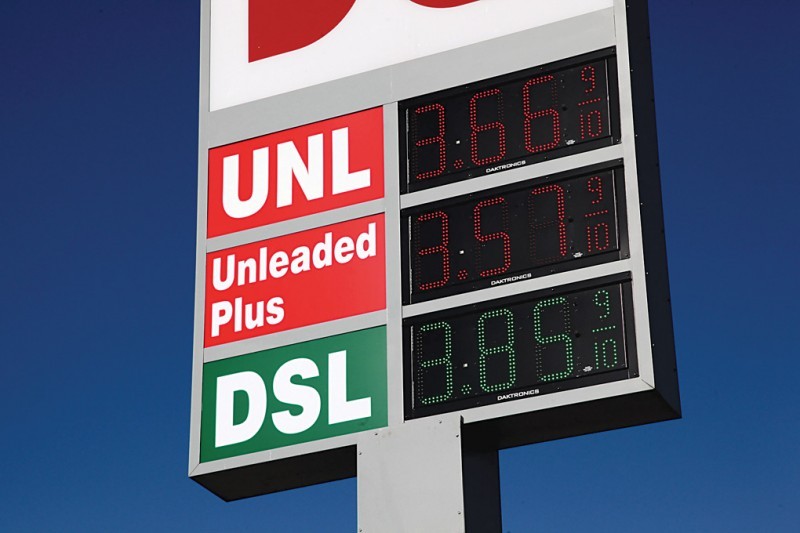Glawe: The president does not control energy prices
March 6, 2012
The political muscling of the week concerns a strengthened consortium in protest of “[Barack] Obama’s failure to restrain rising gas prices.” Ignoring the obsequious flattery, due in part to the ideological ditto-heads, the true issue should be addressed, especially because this is such a pressing one indeed.
It seems the rightists are yet again utilizing Obama as their political scapegoat, casting him out as the American pariah and counterpatriot. The claim is that Obama has failed to prevent climbing gas prices. While he can enact, with legislative support, alternative energy programs, he holds almost no jurisdiction over commodity markets.
Being independent from ideologies allows me the unbiased ability to spelunker the bowels of academic research and find the truth in such matters as this.
Gas prices affect all aspects of our society, and it would be a shame if we jumped to hasty accusations of our president, claiming him to be the root cause, without a strong basis to suggest it.
The first evidence of gas-price volatility arrives without our own conflicted surmising. On Feb. 27, the U.S. Energy Information Administration attempted to expound upon the rising gas prices by providing a detailed report of refinery supply.
According to the report, three major oil refineries have been closed within the last six months, all of which, together, make up 50 percent of total East Coast refining. The speculation is that if the Sunoco Philadelphia refinery closes, inadequate supplies will lead to significant spikes in oil prices.
To quote directly from the research, “The potential loss of the Sunoco Philadelphia refinery presents a complex supply challenge, and no single solution has been identified by industry participants that will address all of the logistical hurdles that must be overcome.”
To compound the situation, there is the addition of two more significant variables. The second evidence concerns heightened tensions between Israel and Iran and, concurrently, between the U.S. and Iran. However, I will not devote this column to Iran’s nuclear program. Iran’s nuclear establishment is a heated issue, and it doesn’t seem as if either side is going to back down as of now.
The escalated conflict, and the addition of sanctions imposed upon Iran by multiple countries, has led to threats from the Iranian government. Faced with global trade embargoes, Iran has threatened to close the Strait of Hormuz. Roughly 40 percent of all U.S. crude oil imports sail through the Strait of Hormuz.
At its narrowest point, the strait is a mere 21 miles wide, making an Iranian blockade relatively easy. Again citing from the Energy Information Administration, shutting down this strait would mean a loss of 17 million barrels of oil a day.
This gives Iran a tremendous amount of leverage, striking a similarity to the 1973 embargo during the Yom Kippur War, a year that experienced massive fuel shortages. The threat of closing the Strait of Hormuz boosts gas prices. Bob Bandos, president and CEO of the Governmental Advisory Committee of North America, which is a marine logistics and service company headquartered in Dubai, stated, “If supply is choked off, the effect would be similar to the fuel shortages of the 1970s — but more extreme.”
The third and final evidence contrary to the conservatives’ claims considers basic supply and demand. Oil companies boost prices, seasonally, in anticipation of the spring driving season. We drive less in the winter and more in the spring and summer. In addition, natural disasters contribute to decreased supply. For instance, in May 2011, oil prices went up because traders were concerned about the closure of multiple refineries due to the Mississippi River floods.
Moreover, “asset bubbles” significantly skew price, which results from commodity traders attempting to create a self-fulfilling prophecy by bidding up future oil prices.
All of these variables culminate into oil-price volatility. Prices fluctuate from so many different variables that it is difficult to forecast price increases, let alone identify specific variables that may be hampering our economy. Given this, how could we possibly place blame solely upon Obama?
Yes, regular gasoline was at an average of $1.85 when Obama took office. But we must not forget that this is sliding off of a huge oil boom, where oil production reached a peak in July 2008, a reflection of increased demand. The average price of oil during this time was skyrocketing at $4 per gallon. In addition, the Great Recession hit stride just before the 2008 elections, and from here we see that oil prices plummet. Again, oil is affected by many different variables, and it seems that each circumstance is slightly different from the other.
I have one final correction to make. For those of you who seem to believe the Keystone Pipeline will magically solve this problem, it won’t. Does anybody realize how long it takes to build a pipeline of this magnitude? How many safety and environmental issues still need to be addressed?
The Keystone Pipeline is not the cure. Nor will the president’s current actions suffice to bandage our short-term woes, my friends. It is frivolous to believe otherwise.

















